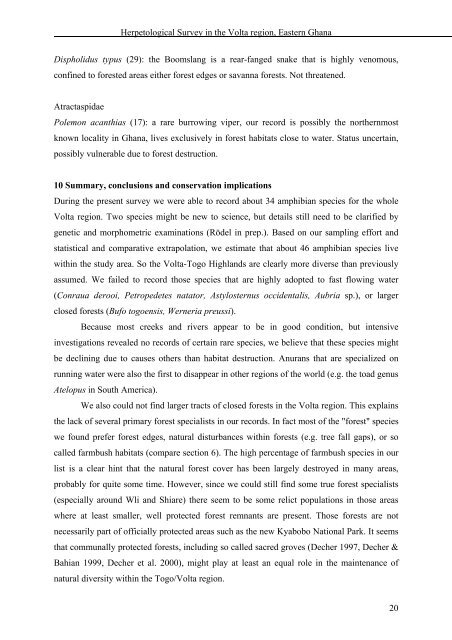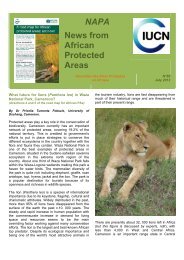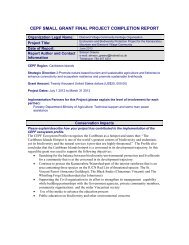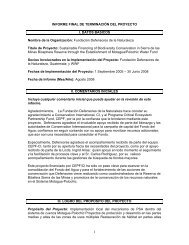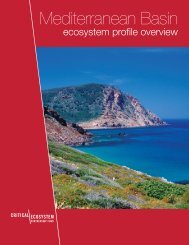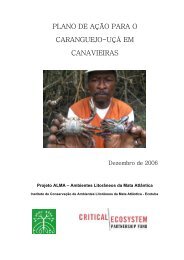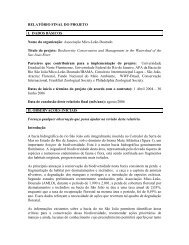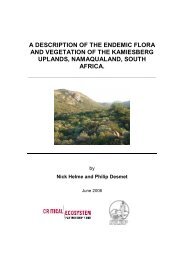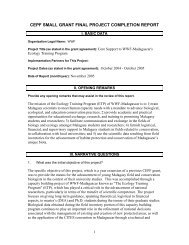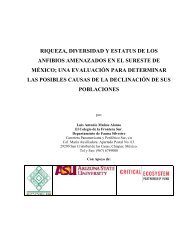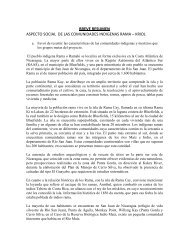Herpetological survey in the Volta region, Eastern Ghana - Critical ...
Herpetological survey in the Volta region, Eastern Ghana - Critical ...
Herpetological survey in the Volta region, Eastern Ghana - Critical ...
Create successful ePaper yourself
Turn your PDF publications into a flip-book with our unique Google optimized e-Paper software.
<strong>Herpetological</strong> Survey <strong>in</strong> <strong>the</strong> <strong>Volta</strong> <strong>region</strong>, <strong>Eastern</strong> <strong>Ghana</strong><br />
Dispholidus typus (29): <strong>the</strong> Boomslang is a rear-fanged snake that is highly venomous,<br />
conf<strong>in</strong>ed to forested areas ei<strong>the</strong>r forest edges or savanna forests. Not threatened.<br />
Atractaspidae<br />
Polemon acanthias (17): a rare burrow<strong>in</strong>g viper, our record is possibly <strong>the</strong> nor<strong>the</strong>rnmost<br />
known locality <strong>in</strong> <strong>Ghana</strong>, lives exclusively <strong>in</strong> forest habitats close to water. Status uncerta<strong>in</strong>,<br />
possibly vulnerable due to forest destruction.<br />
10 Summary, conclusions and conservation implications<br />
Dur<strong>in</strong>g <strong>the</strong> present <strong>survey</strong> we were able to record about 34 amphibian species for <strong>the</strong> whole<br />
<strong>Volta</strong> <strong>region</strong>. Two species might be new to science, but details still need to be clarified by<br />
genetic and morphometric exam<strong>in</strong>ations (Rödel <strong>in</strong> prep.). Based on our sampl<strong>in</strong>g effort and<br />
statistical and comparative extrapolation, we estimate that about 46 amphibian species live<br />
with<strong>in</strong> <strong>the</strong> study area. So <strong>the</strong> <strong>Volta</strong>-Togo Highlands are clearly more diverse than previously<br />
assumed. We failed to record those species that are highly adopted to fast flow<strong>in</strong>g water<br />
(Conraua derooi, Petropedetes natator, Astylosternus occidentalis, Aubria sp.), or larger<br />
closed forests (Bufo togoensis, Werneria preussi).<br />
Because most creeks and rivers appear to be <strong>in</strong> good condition, but <strong>in</strong>tensive<br />
<strong>in</strong>vestigations revealed no records of certa<strong>in</strong> rare species, we believe that <strong>the</strong>se species might<br />
be decl<strong>in</strong><strong>in</strong>g due to causes o<strong>the</strong>rs than habitat destruction. Anurans that are specialized on<br />
runn<strong>in</strong>g water were also <strong>the</strong> first to disappear <strong>in</strong> o<strong>the</strong>r <strong>region</strong>s of <strong>the</strong> world (e.g. <strong>the</strong> toad genus<br />
Atelopus <strong>in</strong> South America).<br />
We also could not f<strong>in</strong>d larger tracts of closed forests <strong>in</strong> <strong>the</strong> <strong>Volta</strong> <strong>region</strong>. This expla<strong>in</strong>s<br />
<strong>the</strong> lack of several primary forest specialists <strong>in</strong> our records. In fact most of <strong>the</strong> "forest" species<br />
we found prefer forest edges, natural disturbances with<strong>in</strong> forests (e.g. tree fall gaps), or so<br />
called farmbush habitats (compare section 6). The high percentage of farmbush species <strong>in</strong> our<br />
list is a clear h<strong>in</strong>t that <strong>the</strong> natural forest cover has been largely destroyed <strong>in</strong> many areas,<br />
probably for quite some time. However, s<strong>in</strong>ce we could still f<strong>in</strong>d some true forest specialists<br />
(especially around Wli and Shiare) <strong>the</strong>re seem to be some relict populations <strong>in</strong> those areas<br />
where at least smaller, well protected forest remnants are present. Those forests are not<br />
necessarily part of officially protected areas such as <strong>the</strong> new Kyabobo National Park. It seems<br />
that communally protected forests, <strong>in</strong>clud<strong>in</strong>g so called sacred groves (Decher 1997, Decher &<br />
Bahian 1999, Decher et al. 2000), might play at least an equal role <strong>in</strong> <strong>the</strong> ma<strong>in</strong>tenance of<br />
natural diversity with<strong>in</strong> <strong>the</strong> Togo/<strong>Volta</strong> <strong>region</strong>.<br />
20


